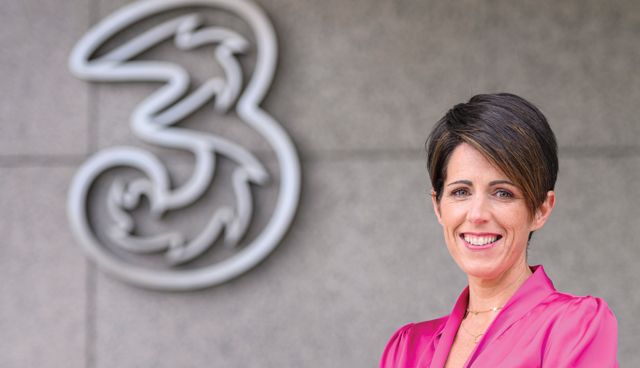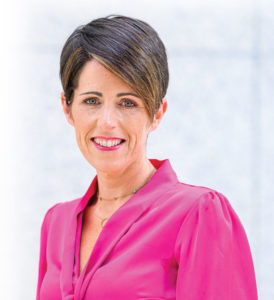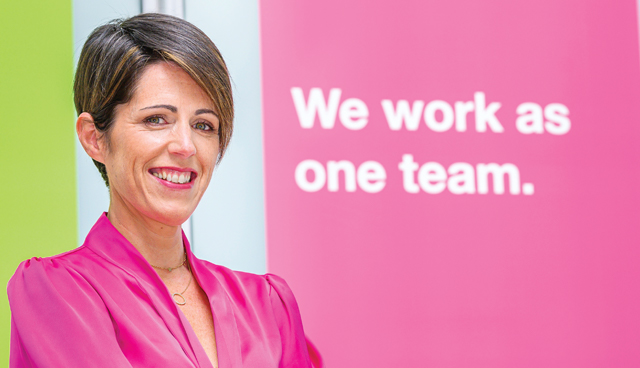Pivoting to a more connected Ireland

The Covid-19 pandemic placed unprecedented demand on Ireland’s communication networks, which became vital in ensuring the country remained connected to loved ones, and to work or schooling. A record number of people are now working remotely, requiring secure and reliable access to the national networks. Head of Business Products, Propositions and Operations with Three, Ciara O’Reilly, speaks to Ciarán Galway about the challenges posed by the pandemic and the opportunities ahead.
“It’s been a white knuckle ride and while the immediate future is somewhat uncertain, one of the things that became crystal clear is that connectivity is the central nervous system for the country,” O’Reilly says, recounting the first four months of the Covid-19 pandemic. In those months, communication and the technology that underpins it became critical, whether for personal reasons or for business.
“It was incredible to be a part of everybody coming together. All the partners, all the competitors, all the companies; everybody came together to achieve stability and to maintain business continuity. We know the impacts are going to be big and there are going to be major economic implications, but I think if we didn’t have the connectivity and technology to bring everybody together quite quickly, we’d have been in a much worse position.”
O’Reilly acknowledges that while the world is consumed by the negative impacts of the pandemic for obvious reasons, she does see positives in the reaction of both business and people during the pandemic and “how we’re making decisions and approaching problem solving”. “We are learning and being more agile, making more decisions on the go. Technology has a key role to play in that. There has been a catalytic effect from a digitisation perspective. We have been thrust into this digital world more quickly than people were ready for in some ways, but we’ve had to adapt, and people are adapting quite well,” she says.
“We found that when most companies are set up to work from home, it’s usually flexibility based, not business continuity based. Suddenly, when everyone has to switch on overnight, it’s a different story. Every sector of business had to do so. Home working policies are great, but when you’re at home and everyone is on the broadband, the children are at home doing schoolwork online, it’s a significant challenge and bigger again if you’re in a rural location.
“That, on top of all the tension at the time, created a difficult scenario. For us, it was about finding solutions for people, be it remote solutions like mobile broadband; it was relatively straightforward to get a lot of people up and running.”

“Today’s children are digital natives; they adapt to these things differently.”
Three also used its international network of sister companies, such as Wind Tre in Italy, where the virus’s progress was weeks ahead of Ireland, in order to read its data and interpret the behaviour it saw from business and consumers. This allowed better preparation for what was to come down the line in Ireland.
To best support their customers, O’Reilly says that Three pulled back on non-essential work to protect the resilience of the network. Having already carried 65 per cent of the country’s data, this saw an average daily increase of 16 per cent in data usage.
“Our network is a critical part of the country’s infrastructure and it is our duty and responsibility to ensure that we maintain it so that our customers can stay connected, and to accommodate this growth, we invested an additional €12 million in to our network. The operators came together and signed up to a set of commitments with ComReg, such as unlimited data,” O’Reilly says. “With Three, you already have All You Can Eat data. We also removed any caps permanently on our All You Can Eat plans. Accessing Gov.ie or any healthcare websites was free. It was very much all hands to the pumps.”
Three also had its own employees to manage, including a large customer care facility in Limerick. O’Reilly says the company had a unified communications solution in place, with Teams and SharePoint already enabled. O’Reilly says that the process of adjustment wasn’t as simple as going home and turning on their laptops, but that it wasn’t far from such a scenario. She says the situation provoked a quicker reaction time from the organisation.
“It could not have been a more appropriate time for our own employees to embrace Three’s connectivity services. We had to pivot, rather than wait until the event was over and diagnose what went wrong. At the time, we identified problems as they happened and adapted in the moment. I think we all have to get more used to that and we are getting used to it. The changes that we have seen and had to deal with have, in a strange way, thrust us into a different way of thinking. The decisions are still well thought out, but we have the freedom to push forward while keeping the best interests of our customers and employees at heart.
“Our network is a critical part of the country’s infrastructure and it is our duty and responsibility to ensure that we maintain it so that our customers can stay connected, and to accommodate this growth, we invested an additional €12 million in to our network. The operators came together and signed up to a set of commitments with ComReg, such as unlimited data. It was very much all hands to the pumps.”
Enabling healthcare
An immediate priority for Three was enabling the mobile connectivity of the public sector, particularly the HSE at such a crucial time. “Take, for instance, HSE CEO Paul Reid, with the testing and tracing regime placed on top of the regular responsibilities that he has to manage in the HSE to keep his staff connected and safe,” O’Reilly says. “This is where the digital ecosystem really comes into play. We recognised the immediate requirement for mobility, allowing employees to move from an office setting to working remotely, but with backups, security and resilience. It was incumbent on us to do that because the Three network is part of the country’s core infrastructure in terms of what we can provide.
“Another big aspect there is Health Mail, the secure email service that allows all healthcare professionals to send and receive completely secure emails. That went through the roof with e-prescriptions and the management of Covid testing. As a comparison: we handled about 630,000 emails in 2019; in April 2020 we handled 670,000. Health Mail was based on a piece of technology that wasn’t going to be sustainable considering the increase we experienced. We needed more resilience and capacity.

“The decision to move something like that to the cloud would usually take a few months, but in these circumstances, it was taken within a week. The decision was made so quickly and now Health Mail is more resilient and secure, you can have different size mailboxes and it’s more efficient from a cost perspective because there isn’t physical hardware to maintain. In the context of digital transformation, it is hugely impressive how quickly the HSE was able to respond, and in return, scale up their services to meet the pressures they are under.”
Post-Covid-19 potential
In what will undoubtedly be a difficult recovery from both economic and societal perspectives, O’Reilly recognises a potential to change Ireland’s decision making for the better. As a mother of three, she sees great opportunity for technology and connectivity to meet the challenges of getting children back to schools.
“If you can imagine the classroom with half the number of students present, the teacher at the front with the whiteboard, all the usual but with a camera in the corner broadcasting the class to a secure Webex,” she illustrates, adding: “That way, the other children who can’t come in or aren’t in that week can interact and bring that bit of energy back to the classroom. Real time interaction would bring back the social aspect of the classroom and the dynamic aspect of learning.
“Today’s children are digital natives; they adapt to these things differently. They don’t have to process it in the same way as those older than them. They’ll guide us to some extent by figuring out what’s going to work for them and what isn’t. Obviously, this all depends on the school and funding being available, but technology can definitely answer some of the challenges being posed now.”
Along with education, health is also predicted to be a huge beneficiary with the widespread implementation of 5G and IoT, and O’Reilly is encouraged by what Three observed during testing of 4G technology on Árainn Mhór in Donegal that will now be applicable to the much faster 5G. One of these tests, done in conjunction with the public sector, were sensors detecting how people requiring care were moving around their homes to try and detect an issue. Three has also been working with Grow Remote around the critical area of connectivity for rural communities.
“One of the things that became clear very quickly is that connectivity is the central nervous system for the country.”
“If those communities don’t have broadband, they’re stuck. If you don’t have the infrastructure, then it’s so much harder to feel engaged and be connected and the isolation is worse again without connectivity,” she says. “Fixed Wire Access [FWA] which will be launched soon, will deliver high speed broadband easily comparable to fixed line. It will be a gamechanger particularly from a rural perspective. What we have seen from the 4G version has been incredible, so we expect great things from the 5G one.
“The reality is that the new way we work is likely to continue, people are happy to work from home and should be able to do so from a rural location. There is considerable work being done rolling out broadband but FWA is a viable and easy option for rural connectivity. People need to be able to run proper email and video conferencing. Until they’re in a position to do that they can’t depend on connectivity to enable business. We are excited about 5G FWA.”
Concluding, O’Reilly again emphasises her hope for the future of connectivity and the potential in the change the pandemic has precipitated: “Covid-19 has turned the world upside down, but I don’t necessarily believe that it’s for the worst. We’re learning and adapting, however the role of connectivity in our lives will very much be dependent on the infrastructure of the future. I think there has definitely been an embracing of technology and a thrust towards digitisation that has been amazing to watch. We have had to do it, and if you asked people before they would have said it was impossible but now, they have found a way around it. There is so much potential in how we apply the known benefits of technology, and now that the resistance to change has been lifted because of Covid-19, we have momentum for continued advancement.”





